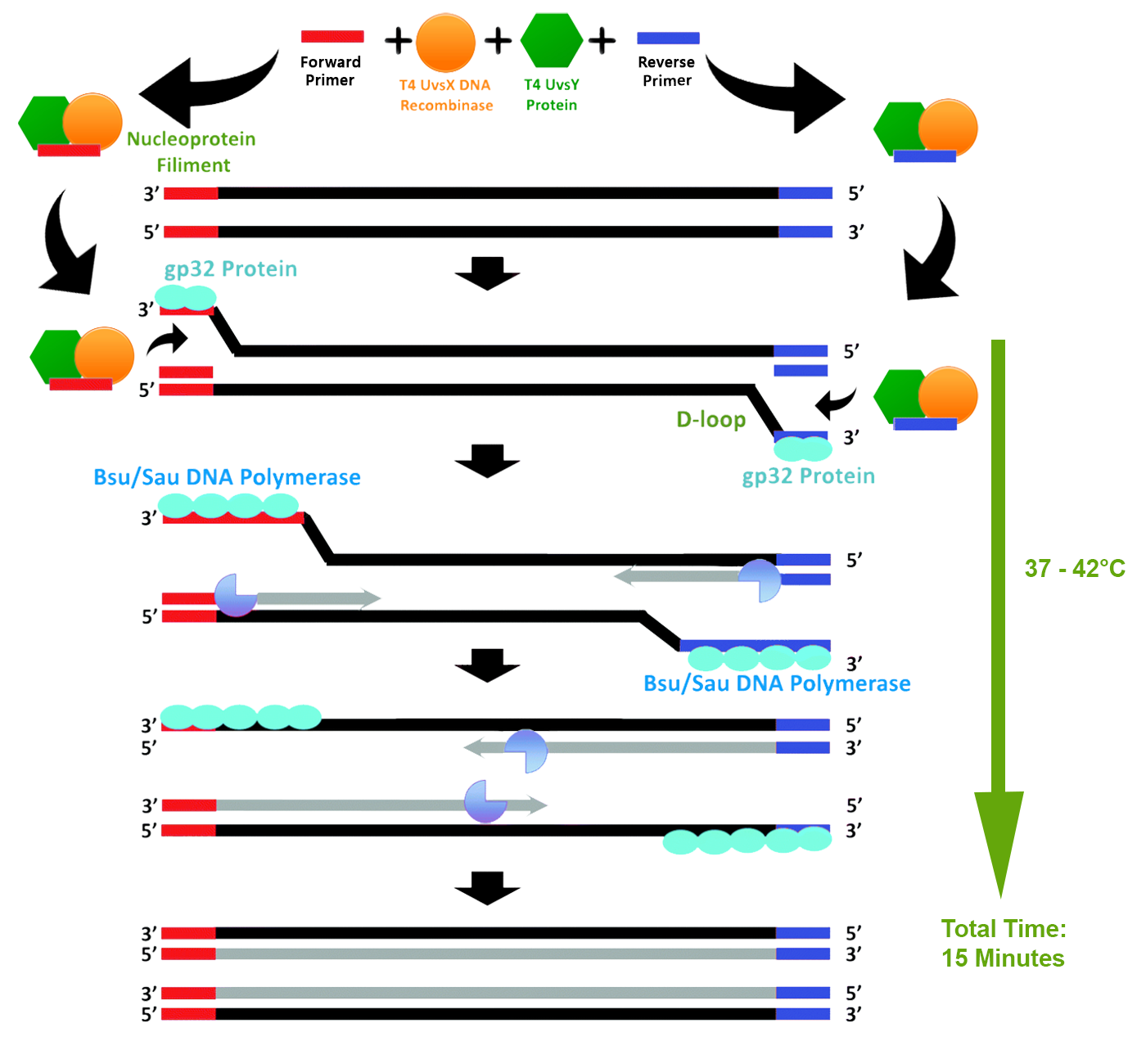 Intact Genomics offers a variety of Recombinase Polymerase Amplification (RPA) optimization products. RPA is an excellent candidate for developing rapid point-of-care molecular testing tools as well as agricultural applications, clonal amplification in next-generation sequencing workflows, and more.
Intact Genomics offers a variety of Recombinase Polymerase Amplification (RPA) optimization products. RPA is an excellent candidate for developing rapid point-of-care molecular testing tools as well as agricultural applications, clonal amplification in next-generation sequencing workflows, and more.
| Product Links | Package Size | Features |
| IG® RPA Master Mix | 25 rxns, 100 rxns, 500 rxns | IG RPA Master Mix delivers powerful isothermal amplification for your molecular diagnostics and research. Easy-to-use, fast, reliable, and more affordable. |
| ig® Recombinase Polymerase Amplification (RPA) Kit v2 | 25 rxns, 100 rxns, 500 rxns | The new improved IG® Recombinase Polymerase Amplification Version 2 Kit (IG® RPA v2) helps researchers who seek the advantages of isothermal DNA amplification to achieve faster, more discernible results. |
| FastAmp® qRPA SYBR kit | 25 rxns, 100 rxns, 500 rxns | FastAmp® qRPA SYBR Kit is a powerful tool to screen primer conditions for the lowest possible Non-template control (NTC) background. |
| FastAmp® Plant Direct RPA kit | 25 rxns, 100 rxns, 500 rxns | FastAmp® Plant Direct RPA kit offers a fast, robust method for amplifying DNA fragments from plant tissues at a single and constant temperature (37°C) using RPA technology. |
| ig® Recombinase Polymerase Amplification (RPA) Kit | 25 rxns, 100 rxns, 500 rxns | This introductory kit gives the user a faster, more streamlined Recombinase Polymerase Amplification experience by providing the necessary reagents and enzymes to amplify user-provided DNA template. |
| T4 UvsX DNA Recombinase | 100 μg, 500 μg, & 1000 µg | Important for the error-free repair of DNA double-strand breaks and for replication fork restart |
| T4 UvsY Protein | 100 μg, 500 μg, & 1000 µg | T4 UvsY is the phage T4 recombination mediator protein. It stimulate sthe filament nucleation event |
| T4 gp32 Protein | 100 µg, 200 µg, 500 μg | Single-stranded DNA binding protein required for T4 DNA replication, recombination, and repair |
| Bsu DNA Polymerase Large Fragment | 1,000 units | Polymerase useful for extending primers in RPA |
| Sau DNA Polymerase Large Fragment | 1,000 units | Polymerase useful for extending primers in RPA |
| Glycerol Free T4 UvsX DNA Recombinase | 100 μg, 500 μg, & 1000 µg | Important for the error-free repair of DNA double-strand breaks and for replication fork restart |
| Glycerol Free T4 UvsY Protein | 100 μg, 500 μg, & 1000 µg | T4 UvsY is the phage T4 recombination mediator protein. It stimulate sthe filament nucleation event |
| Glycerol Free T4 gp32 Protein | 500 μg | Single-stranded DNA binding protein required for T4 DNA replication, recombination, and repair |
| Glycerol Free Bsu DNA Polymerase Large Fragment | 1,000 units | Polymerase useful for extending primers in RPA |
| Exonuclease III | 10000 units, 25000 units | Exonuclease III (Exo III) is an exodeoxyribonuclease that digests one strand of duplex DNA from a blunt end, 5′ overhang or nick |
| Endonuclease IV(Nfo) | 2000 units, 5000 units | Endonuclease IV (Nfo) from Escherichia coli is a 32-kD metalloprotein that aids in the repair of damaged DNA. The enzyme functions both as an apurinic/apyrimidinic nuclease and as a 3′-terminal di-esterase |
| FastAmp® Viral and Cell Lysis Solution (1x, 5x) | 25 reactions, 100 reactions | FastAmp® Viral and Cell Lysis Solution streamlines DNA and RNA collection and storage processes. The lysed DNA or RNA can be directly used in RPA, RT-isothermal DNA amplification, PCR and RT-qPCR, , without the need of an extraction step. |
Recombinase Polymerase Amplification (RPA) amplifies DNA at a constant temperature (37-42 °C) using a recombinase (e.g. UvsX), primers, a single-stranded DNA binding protein (SSB), and a strand displacing DNA polymerase. T4 UvsX is used in combination with its accessory protein, UvsY. The recombinase interacts with the primers to form nucleoprotein filament. This complex is able to bind with homologous double-stranded DNA through a strand exchange. After the exchange, a single-stranded binding protein, T4 gp32, stabilizes the displaced strand. Finally, Bsu/Sau polymerase extends the primers, creating a new complete copy of the template, and amplification can continue like Polymerase Chain Reaction (PCR).


Intact Genomics offers a variety of Recombinase Polymerase Amplification (RPA) optimization enzymes and kits. All enzymes thoroughly tested for activity, purity and concentration. We are continuously discovering and developing novel classes of RPA enzymes in order to speed up the point-of-care (POC) diagnostic process.
Applications and Benefits:
- Highly selective and sensitive isothermal amplification technique.
- Alternative to PCR. No Thermocycler needed.
- Speed and sensitivity. Excellent for Rapid Molecular and Agricultural tests. This isothermal reaction employing T4 UvsX DNA Recombinase does not require pretreatment of DNA, nor does it require any strand denaturation, making it suitable for field tests or performing tests with minimal equipment and supplies.
- Successfully implementation with different detection strategies, from end-point lateral flow strips to real-time fluorescent detection.
